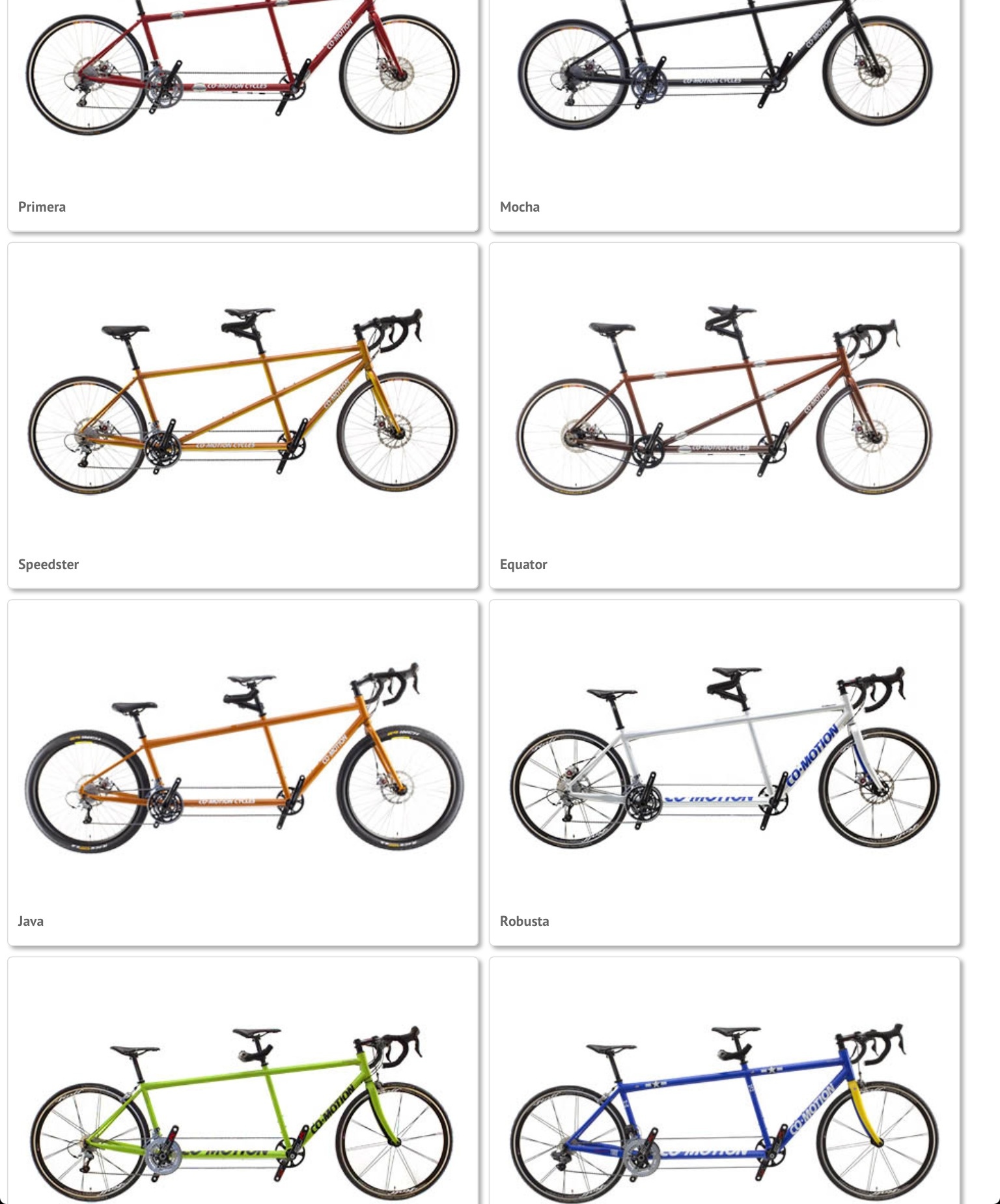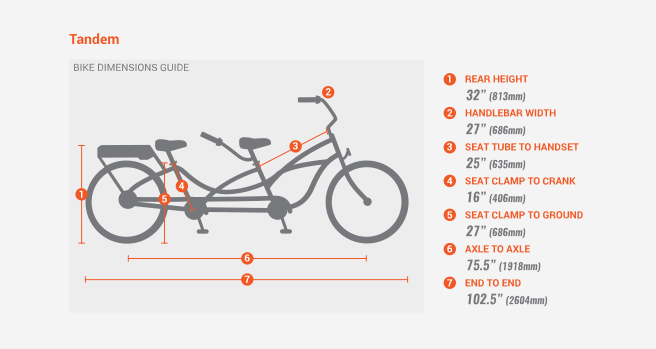Choosing The Right Size
When it comes to tandem bikes, choosing the right size is crucial for a comfortable and enjoyable riding experience. No matter if you’re a beginner or a seasoned rider, the proper frame size is essential to ensure that you and your partner can pedal together seamlessly. Here’s a guide to help you determine what size tandem bike you need.
Small Frame Size
A small frame size for a tandem bike is usually suitable for riders with a height range between 5’0″ to 5’6″. This size allows for easy mounting and dismounting, making it ideal for shorter individuals. Riders with smaller stature often find this size comfortable and manageable, enabling them to handle the bike efficiently.
Medium Frame Size
For riders with a height range of 5’7″ to 6’0″, a medium frame size is typically recommended. This site offers a balance of comfort and maneuverability, making it suitable for a wide range of riders. Additionally, a medium frame size provides adequate leg extension and handlebar reach, contributing to a more natural riding posture.
Large Frame Size
Individuals with a height range of 6’1″ and above would generally benefit from a large frame size. This allows taller riders to have ample space and leg extension, resulting in a comfortable and efficient riding experience. The larger frame size also provides better stability and control, especially for riders with longer limbs.
Importance Of Fit
When it comes to choosing the right size tandem bike, the importance of fit cannot be overstated. A properly fitted tandem bike ensures comfort, efficiency, and, most importantly, safety. Let’s delve into the significance of fit in these three aspects.
Comfort
Comfort is crucial when it comes to riding a tandem bike. The right size ensures that both riders have ample space and are not cramped, leading to a more enjoyable riding experience.
Efficiency
Efficiency is directly linked to the size of a tandem bike. A well-fitted bike allows both riders to pedal in sync, maximizing the propulsion and making the ride smoother and more efficient.
Safety
Safety is the top priority when it comes to cycling. A properly sized tandem bike ensures that both riders can maintain balance, steer properly, and have full control of the bike, significantly reducing the risk of accidents.
Testing And Adjusting
To ensure a smooth and enjoyable tandem biking experience, it is essential to thoroughly test and adjust the bike’s settings. Proper testing and adjusting will enhance comfort, control, and overall performance while riding. In this section, we will explore the key aspects of Testing and Adjusting for your tandem bike.
Test Ride
Before setting out on a tandem biking adventure, always perform a test ride to get a feel for the bike’s handling and comfort.
Saddle Height
Adjust the saddle height to ensure optimal leg extension when pedaling, preventing discomfort and improving efficiency.
Handlebar Position
Position the handlebars at a height and distance that allow for a comfortable reach and proper steering control.
Special Considerations
Special Considerations:
Child/adult Combinations
When choosing the size of a tandem bike, consider the combination of a child and an adult riding together. Ensure the child can comfortably reach the pedals while the adult maintains proper control of the bike.
Weight Limits
Verify the weight limits specified by the manufacturer to ensure the safety and efficiency of the tandem bike. Exceeding weight limits can impact the performance and longevity of the bike.
Frame Design
Evaluate the frame design of the tandem bike to accommodate the riders’ proportions and preferences. Select a frame that offers stability and comfort for both riders throughout the journey.
Additional Accessories
Once you’ve determined the right size tandem bike for you and your partner, it’s time to consider the additional accessories that can enhance your riding experience. These accessories not only provide convenience but also ensure your safety and the safety of others on the road.
Stokers’ Accessories
Stokers, or the riders in the rear position of a tandem bike, have important accessories to consider. These accessories are designed to provide them with comfort and control, allowing them to fully enjoy the ride.
1. Stoker Handlebars:
Stokers can benefit from having their own set of handlebars, which provide them with better control and balance. These handlebars are typically attached to the seat post and allow the stokers to contribute to the steering of the tandem bike.
2. Stoker Pedals:
Stokers’ pedals are specifically designed to accommodate their feet and provide a comfortable and efficient pedaling experience. These pedals often have adjustable straps or clips to secure the stokers’ feet in place.
Safety Gear
Ensuring the safety of both riders is of utmost importance when riding a tandem bike. Here are some essential safety gear accessories that should be considered:
1. Helmets:
Wearing helmets is a must for every cyclist, and it is no different when riding a tandem bike. Make sure to invest in helmets that are properly fitted and meet safety standards to protect your head in case of an accident.
2. Reflectors and Lights:
Enhance your visibility on the road by outfitting your tandem bike with reflectors and lights. These accessories are crucial, especially when riding during low-light conditions or at night, as they make you more noticeable to other motorists.
Storage Solutions
Tandem bikes are larger than regular bikes, so finding appropriate storage solutions can be a challenge. Here are some handy storage accessories to consider:
1. Rack and Panniers:
Install a rear rack on your tandem bike that allows you to attach panniers. These panniers provide ample storage space for carrying essentials such as snacks, water bottles, repair kits, and extra clothing.
2. Bike Covers:
To protect your tandem bike from the elements when not in use, invest in a high-quality bike cover. This will help prevent any damage caused by exposure to rain, UV rays, or dust, ensuring your bike stays in top condition for years to come.

Credit: www.cyclingabout.com
Consulting An Expert
Local Bike Shop
If you’re wondering what size tandem bike you need, your local bike shop can be a valuable resource. Bike shops often have experienced staff who can provide tailored advice based on your specific needs and preferences. They can also help you choose the right size by considering factors such as your height, weight, and riding style.
Professional Bike Fit
A professional bike fit is a comprehensive way to ensure that you’re getting the right size tandem bike. Professional fitters have the expertise and equipment to analyze your body measurements, flexibility, and riding dynamics. They can fine-tune the bike’s components to fit your body perfectly, leading to a more comfortable and efficient riding experience.

Credit: www.freewheeling.ca
Frequently Asked Questions For What Size Tandem Bike Do I Need
What Size Tandem Do I Need?
To determine the size of the tandem you need, consider the combined weight capacity and adjustability for comfort.
How To Choose a Tandem Bike?
To choose a tandem bike, consider the frame material, size, and weight capacity. Pay attention to the riding style (casual or competitive) and the terrain you plan to ride on. Ensure good coordination with your partner and test-ride the bike before buying to see if it feels comfortable for both riders.
What Is The Average Length Of A Tandem Bike?
The average length of a tandem bike is around 8 to 9 feet.
Should A Heavier Person Be In The Front Or Back On A Tandem Bike?
The heavier person should be in front of a tandem bike for better balance and control.
Conclusion
Finding the right tandem bike size is crucial for a comfortable and enjoyable ride. Take your time to measure and consider your height and riding preferences. Remember, the perfect size enhances your cycling experience. Now you’re all set to hit the road and create wonderful biking memories with your tandem partner!
To determine the right size tandem bike, consider the height and build of both riders. Measure the captain’s inseam and the stoker’s stand-over height.
If you are both of similar builds, a medium-sized tandem bike may work. However, if there is a considerable difference in height, you might need a smaller or larger size to ensure a comfortable fit for both riders. Riding a tandem bike can be a fun and enjoyable experience for couples or friends who want to share the joy of cycling together.
However, choosing the right size tandem bike is crucial to ensure a comfortable and safe ride. In this guide, we will discuss the factors to consider when determining the appropriate size tandem bike for you and your riding partner. Understanding these considerations will help you make an informed decision and choose a tandem bike that suits both your needs and preferences.
Factors To Consider
When choosing the right tandem bike, there are several important factors to consider. These factors will ensure that the bike you select is the perfect fit for you and your riding partner. From body measurements to riding style and terrain, each aspect plays a crucial role in determining the right size tandem bike for you.
Body Measurements
Before purchasing a tandem bike, it’s essential to consider the body measurements of both riders. Keep in mind that tandem bikes are available in various sizes, and finding the right fit is crucial for comfort and performance. The most important measurements to consider are inseam length, height, and reach. It’s recommended to measure these dimensions accurately to determine the appropriate frame size for your tandem bike.
Riding Style
Different riders have different riding styles, and it’s important to choose a tandem bike that aligns with your preferences. Whether you enjoy leisurely rides or high-speed adventures, the riding style will impact the type of tandem bike you should choose. For instance, if you prefer off-road adventures and rugged terrains, a mountain bike tandem would be the ideal choice. On the other hand, if you plan on cycling on smooth roads or paved trails, a road bike tandem might suit you best.
Terrain
The terrain you plan to ride on is another critical factor that should influence your tandem bike selection. Consider the types of trails and roads in your desired riding areas. If you live in an area with steep hills and challenging terrains, a tandem bike with a wider range of gears and strong braking systems would be advantageous. On the other hand, if you anticipate mostly flat and smooth surfaces, a tandem bike with a more aerodynamic design and lighter frame could be suitable.
By carefully considering these factors, you can confidently choose the right tandem bike size for you and your riding partner. Remember that finding the perfect fit will ensure a more enjoyable and comfortable biking experience, whether you’re cruising through scenic trails or embarking on epic adventures together.

Credit: www.cyclingabout.com
Determining Frame Size
When selecting a tandem bike, determining the right frame size is crucial for comfort and safety. This requires considering measurements like standover height, top tube length, and seat tube length. Each of these factors plays a significant role in ensuring a proper fit for both riders.
Standover Height
Standover height is the distance from the ground to the top tube of the bike frame. To determine the correct standover height for a tandem bike, both riders should stand over the bike with their feet flat on the ground. There should be a few inches of clearance between the top tube and each rider’s inseam.
Top Tube Length
The top tube length is the horizontal distance from the head tube to the seat tube. It influences the reach of each rider to the handlebars. An appropriate top tube length ensures a comfortable riding position without straining the back or shoulders. Riders should be able to comfortably reach the handlebars without overreaching.
Seat Tube Length
Seat tube length is the vertical distance from the bottom bracket to the top of the seat tube. This measurement determines the saddle height and how well each rider can extend their legs for efficient pedaling. A proper seat tube length ensures that each rider can achieve optimal leg extension for a smooth and effective pedaling motion.
Choosing The Right Size
When it comes to tandem bikes, choosing the right size is crucial for a comfortable and enjoyable riding experience. No matter if you’re a beginner or a seasoned rider, the proper frame size is essential to ensure that you and your partner can pedal together seamlessly. Here’s a guide to help you determine what size tandem bike you need.
Small Frame Size
A small frame size for a tandem bike is usually suitable for riders with a height range between 5’0″ to 5’6″. This size allows for easy mounting and dismounting, making it ideal for shorter individuals. Riders with smaller stature often find this size comfortable and manageable, enabling them to handle the bike efficiently.
Medium Frame Size
For riders with a height range of 5’7″ to 6’0″, a medium frame size is typically recommended. This site offers a balance of comfort and maneuverability, making it suitable for a wide range of riders. Additionally, a medium frame size provides adequate leg extension and handlebar reach, contributing to a more natural riding posture.
Large Frame Size
Individuals with a height range of 6’1″ and above would generally benefit from a large frame size. This allows taller riders to have ample space and leg extension, resulting in a comfortable and efficient riding experience. The larger frame size also provides better stability and control, especially for riders with longer limbs.
Importance Of Fit
When it comes to choosing the right size tandem bike, the importance of fit cannot be overstated. A properly fitted tandem bike ensures comfort, efficiency, and, most importantly, safety. Let’s delve into the significance of fit in these three aspects.
Comfort
Comfort is crucial when it comes to riding a tandem bike. The right size ensures that both riders have ample space and are not cramped, leading to a more enjoyable riding experience.
Efficiency
Efficiency is directly linked to the size of a tandem bike. A well-fitted bike allows both riders to pedal in sync, maximizing the propulsion and making the ride smoother and more efficient.
Safety
Safety is the top priority when it comes to cycling. A properly sized tandem bike ensures that both riders can maintain balance, steer properly, and have full control of the bike, significantly reducing the risk of accidents.
Testing And Adjusting
To ensure a smooth and enjoyable tandem biking experience, it is essential to thoroughly test and adjust the bike’s settings. Proper testing and adjusting will enhance comfort, control, and overall performance while riding. In this section, we will explore the key aspects of Testing and Adjusting for your tandem bike.
Test Ride
Before setting out on a tandem biking adventure, always perform a test ride to get a feel for the bike’s handling and comfort.
Saddle Height
Adjust the saddle height to ensure optimal leg extension when pedaling, preventing discomfort and improving efficiency.
Handlebar Position
Position the handlebars at a height and distance that allow for a comfortable reach and proper steering control.
Special Considerations
Special Considerations:
Child/adult Combinations
When choosing the size of a tandem bike, consider the combination of a child and an adult riding together. Ensure the child can comfortably reach the pedals while the adult maintains proper control of the bike.
Weight Limits
Verify the weight limits specified by the manufacturer to ensure the safety and efficiency of the tandem bike. Exceeding weight limits can impact the performance and longevity of the bike.
Frame Design
Evaluate the frame design of the tandem bike to accommodate the riders’ proportions and preferences. Select a frame that offers stability and comfort for both riders throughout the journey.
Additional Accessories
Once you’ve determined the right size tandem bike for you and your partner, it’s time to consider the additional accessories that can enhance your riding experience. These accessories not only provide convenience but also ensure your safety and the safety of others on the road.
Stokers’ Accessories
Stokers, or the riders in the rear position of a tandem bike, have important accessories to consider. These accessories are designed to provide them with comfort and control, allowing them to fully enjoy the ride.
1. Stoker Handlebars:
Stokers can benefit from having their own set of handlebars, which provide them with better control and balance. These handlebars are typically attached to the seat post and allow the stokers to contribute to the steering of the tandem bike.
2. Stoker Pedals:
Stokers’ pedals are specifically designed to accommodate their feet and provide a comfortable and efficient pedaling experience. These pedals often have adjustable straps or clips to secure the stokers’ feet in place.
Safety Gear
Ensuring the safety of both riders is of utmost importance when riding a tandem bike. Here are some essential safety gear accessories that should be considered:
1. Helmets:
Wearing helmets is a must for every cyclist, and it is no different when riding a tandem bike. Make sure to invest in helmets that are properly fitted and meet safety standards to protect your head in case of an accident.
2. Reflectors and Lights:
Enhance your visibility on the road by outfitting your tandem bike with reflectors and lights. These accessories are crucial, especially when riding during low-light conditions or at night, as they make you more noticeable to other motorists.
Storage Solutions
Tandem bikes are larger than regular bikes, so finding appropriate storage solutions can be a challenge. Here are some handy storage accessories to consider:
1. Rack and Panniers:
Install a rear rack on your tandem bike that allows you to attach panniers. These panniers provide ample storage space for carrying essentials such as snacks, water bottles, repair kits, and extra clothing.
2. Bike Covers:
To protect your tandem bike from the elements when not in use, invest in a high-quality bike cover. This will help prevent any damage caused by exposure to rain, UV rays, or dust, ensuring your bike stays in top condition for years to come.

Credit: www.cyclingabout.com
Consulting An Expert
Local Bike Shop
If you’re wondering what size tandem bike you need, your local bike shop can be a valuable resource. Bike shops often have experienced staff who can provide tailored advice based on your specific needs and preferences. They can also help you choose the right size by considering factors such as your height, weight, and riding style.
Professional Bike Fit
A professional bike fit is a comprehensive way to ensure that you’re getting the right size tandem bike. Professional fitters have the expertise and equipment to analyze your body measurements, flexibility, and riding dynamics. They can fine-tune the bike’s components to fit your body perfectly, leading to a more comfortable and efficient riding experience.

Credit: www.freewheeling.ca
Frequently Asked Questions For What Size Tandem Bike Do I Need
What Size Tandem Do I Need?
To determine the size of the tandem you need, consider the combined weight capacity and adjustability for comfort.
How To Choose a Tandem Bike?
To choose a tandem bike, consider the frame material, size, and weight capacity. Pay attention to the riding style (casual or competitive) and the terrain you plan to ride on. Ensure good coordination with your partner and test-ride the bike before buying to see if it feels comfortable for both riders.
What Is The Average Length Of A Tandem Bike?
The average length of a tandem bike is around 8 to 9 feet.
Should A Heavier Person Be In The Front Or Back On A Tandem Bike?
The heavier person should be in front of a tandem bike for better balance and control.
Conclusion
Finding the right tandem bike size is crucial for a comfortable and enjoyable ride. Take your time to measure and consider your height and riding preferences. Remember, the perfect size enhances your cycling experience. Now you’re all set to hit the road and create wonderful biking memories with your tandem partner!



